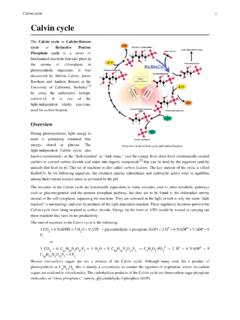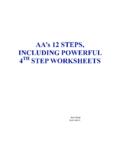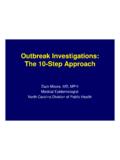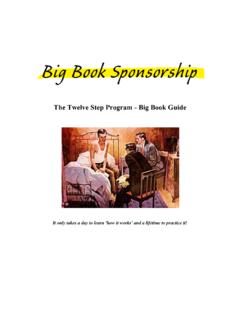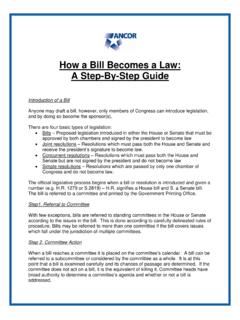Transcription of 10 - Muscular Contraction - Taft College
1 10 - Muscular ContractionTaft College Human PhysiologyMuscular Contraction Sliding filament theory (Hanson and Huxley, 1954) These 2 investigators proposed that skeletal muscle shortens during Contraction because the thick (myosin) and thin (actin) filaments slide past one another. The previous idea was that the filaments change in length. The myosin heads pull the thin filaments toward the center of the sarcomerewhich shortens the sarcomere. Remember, the I band and the H zones disappearas the thin filaments move to the center. The A band stays the samelength. Only the length of the sarcomerechanges, not the length of the filaments!2 SarcomeresSarcomere SarcomereCloser Look at the Events During Contraction We will now take a look at Contraction in a step -by- step fashion.
2 We will discuss 17 stepsduring a muscle Contraction event. Figure , explains these events in 9 steps. It is not important that you can name a step , but that you can explain how muscle Contraction During Muscle ContractionDiagramIn TextEvents During Muscle Contraction (Steps 1- 4 represent nerve impulse) 1. Nerve impulsearrives at neural Muscular junction. 2. ACh releasefrom axon terminals. 3. ACh binds toactive sites (receptors)on motor end plate. 4a. AChreceptor protein channel opens and increases permeability of Na+ into sarcoplasm. 4b. If there is enough ACh, an action potential(AP)willoccur. 4c. Acetylcholinesterasedegrades ACh. Events During Muscle Contraction (Steps 5-7 represent depolarization.)
3 5. Na+ enters muscle fiber, rapid depolarization of sarcolemmaoccurs = action potential. Voltage changes to a less negative charge. 6. The action potential spreads away from the end plate in all directions and depolarizes the T tubules. 7. The action potential continues down the T tubules into the sarcoplasm where it depolarizes the sarcoplasmic reticulum (SR) During Muscle Contraction 8. The SR respondsto the action potential by opening Ca++release channels which floodsthe surrounding sarcoplasmlocated between the thick and thin filaments with Ca++. 9. Ca++combines withregulatory protein troponin,associated with actin filaments. 10. Troponin changes shape, and exposes the myosin binding sites on actin.
4 Steps 5-10 are all a part of the latent period= lag timebetween stimulation and Role of Ca++ in ContractionEvents During Muscle Contraction 11. Myosin heads(cross bridges) attach to actin binding siteson thin filament. 12. Myosin head flexes(tilts, shifts), drawing actinfilaments of sarcomere toward each other. 13. Once myosin head is flexed, ATP binding site is exposedand ATP binds to the head. 14. Myosin head detachesfrom actin binding site under the influence of ATP binding. Energy from ATP returns the myosin head to the cocked forward position. Myosin head attaches to a new binding site on actin. (Steps 11-14 = Contractionand are repeated over and over during a single Contraction event as long as ATP and Ca++ are available.)
5 MyosinactinZThe Contraction Cycle11121314 Rigor Mortis = Stiff Death Rigor mortis- Notice that ATP is responsible for myosin heads detaching from actin,which leads to muscle relaxation. This is illustrated by rigor mortis = stiff death. When a person dies, no more ATP is synthesized as no more 02and glucose are supplied to the tissues. The myosin heads cannot detach themselves from actinresulting in a condition in which muscles are in a state of rigidity called rigor mortis. The muscles contract as Ca++ diffuses out of sarcoplasmic reticulum (the Ca++ pump energized by ATP has quit working). This state lasts about 24 hours and disappears as the tissues undergo During Muscle Contraction Steps 15-17 = Relaxation 15.
6 Ca++ is returned to the SR by Ca++ active transport pump (requires ATP).Sarcoplasm is now Ca++ poor. 16. Troponin again covers actin binding sites. Therefore no myosin actin interaction can occur. 17. Muscle fiber relaxes. Movement of relaxation is due to: A. "Elastic effect" of coiled elastic fiber (titan)molecules. And/or, B. Due to pull of within binds to motor end permeability of Na+into of sarcolemma, action of of SR releases Ca++between thin & thick ++combines w/ changes shape and exposes myosin binding heads attach to actinbinding heads tilts/shifts drawing actins of sarcomeretoward each of myosin head exposes ATP binding site- ATP head detaches, ATP repositions myosin head, myosin bind to new ++is returned to again covers actin-myosin binding relaxes11716159-1011-14 = Contraction 23-56-8 ATP and Contraction We see that ATPis required for 3 major rolesin Contraction : 1.
7 Repositions (cocks) the myosin heads. 2. Detachment of myosin headsfrom actinonce the power stroke is complete. 3. Powers the Ca++ active transport pumpsthat rapidly remove Ca++ from the sarcoplasmback into the sarcoplasmic reticulum (reservoir). The concentration of Ca++ is 10,000 times lower in the sarcoplasm of a relaxed muscle fiber than inside the SR. ATP Produced in 3 Ways ATP is very important but muscle only stores enough for about 4-6 seconds of activity ATP is produced in 3 ways 1. Phosphagen System= ATP Creatine Phosphate System Product = 1 ATP+ 1 creatine phosphate + 1 creatine Duration of energy = 15 seconds Function= Quick Power , 100 meter sprintATP Produced in 3 Ways2.
8 Anaerobic System= Glycogen Lactic Acid SystemProduct = 2 ATP/ GlucoseDuration = 30- 40 SecondsFunction = 300 meter sprint Lactic acidis produced as a waste product that cause burning sensationand pain. Together creatine phosphate (1) and anaerobic system (2) can provide enough ATP for a 400 meter out OxygenATP Produced in 3 Ways3. Aerobic System= Aerobic Respiration With OxygenProduct = 36 ATP/ GlucoseDuration = HoursFunction = Aerobic work , long distancerunning or swimming36 Occurs in MitochondriaOxygen Consumption after Exercise oxygen debt = recovery oxygen uptake(Older term)(New term) = the amount of oxygen that must be paid back to the body following exercise Oxygen does 3 things: 1.
9 Converts the lactic acid back into glycogen(fuel) stores in the liver 2. Allows productionof creatinine phosphate and ATP. 3. Replaces oxygenremoved from storage in muscle tissue (myoglobin).Physiological Properties of Muscles Stimulus= an impulse. An impulse may travel along a motor neuron that is not strong enough to cause a Contraction . A stimulus that does not cause a response by the muscle is called subliminalor subthresholdstimulus. (Ex. -70 mv to -60 mv) By increasing the stimulus, a barely perceptible response may beobtained = liminalor thresholdstimulus. (Ex -70 to -55 mv). A liminal stimulus is just strong enough to cause a depolarization and production of an action potential.
10 All or none if thresholdis reached all muscle cells of a motor unit will contract maximally, if not reached, none will Polarized at Rest =-70 mVWhen thresholdis reached, a rapid depolarizationoccurs called an action potentialthat leads to a muscle Contraction . 1stDomino Grading of the Strength of a Muscle Contraction How can we control how much strength a muscle (like the biceps or triceps brachii) produces? An individual motor unit fires all muscle fibersin that unit in an all or none fashion. All fibers contract to their fullest extent or not at all. However, the tension or force produced by an entire musclecan be adjusted. There are 2 ways to control strength of a muscle Contraction : 1.


